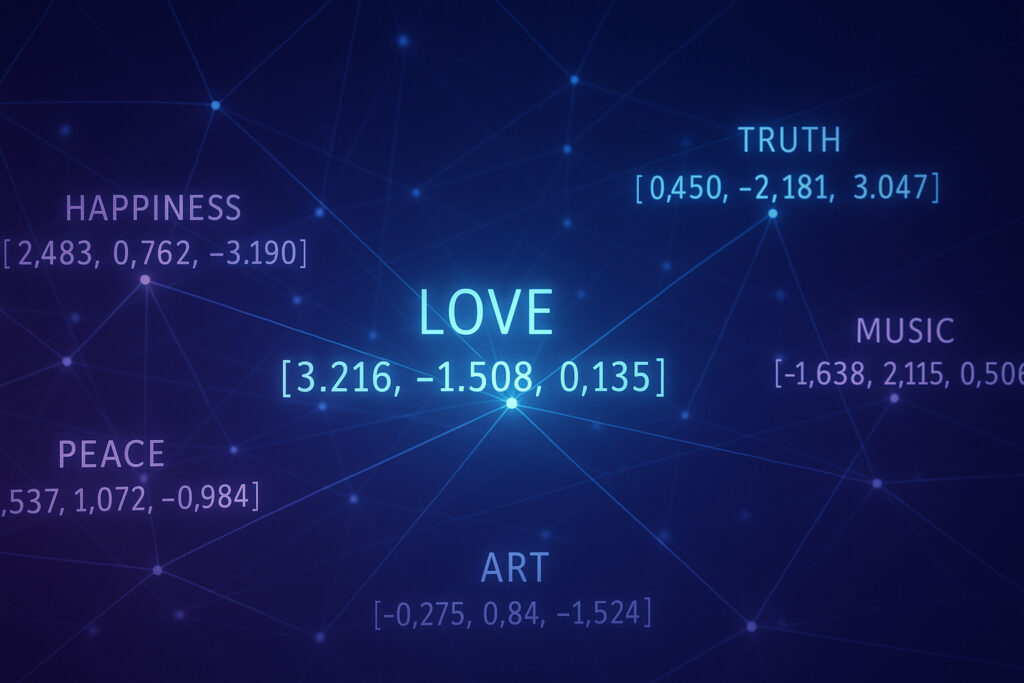Contents
Introduction
In today’s digital world, billions of people exchange meanings every day—writing messages, searching for answers, debating in comments, and forming their own “reality bubbles.” But what makes a dialogue between a human and a machine possible? How does an algorithm distinguish between a “cat” and a “chair,” and why does it suddenly begin to “understand” meaning? The answer is embedding.
Embedding isn’t just another buzzword in the arsenal of artificial intelligence. It’s the intersection point of two worlds: the world of meanings and the world of digital space. It’s the moment when something formless—a meaning, an idea, a mood—receives a digital body for the first time.

What is an embedding?
Embedding (from the English “embedding” — to embed, to immerse) is a way to insert something intangible (like a word or an idea) into a material structure—a fixed-length vector of numbers.
Simply put, embedding is an imprint of meaning, mapped into a multi-dimensional space.
Example:
The word “love” turns into a vector, for example, of 384 numbers:[0.12, -0.57, 0.44, ...]
The same thing happens with entire sentences, paragraphs, and sometimes even images or people (for instance, user embeddings in recommendation systems).
Why do we need this?
At first glance, this might seem like just another mathematical trick. But in reality, it’s a new form of existence for meaning.
A computer doesn’t understand words, but it can compare numbers. So if “cat” and “kitty” are close to each other in this space, the algorithm understands: there’s something in common between them.
- Semantic search: If you search for “the sun is setting,” the algorithm can find “sunset” even if the words don’t match exactly.
- Clustering: Texts similar in topic are automatically grouped together.
- Recommendations: Similar movies, products, or articles—even if you describe them “in your own words.”
How is an embedding created?
Meaning is transformed into numbers through the training of large models (like transformers). These models are shown millions of texts and taught to look for patterns: “If these two texts appear in similar contexts, their meanings are probably similar.”
Through this training, a hidden space of meanings is formed—an invisible map where each word or text receives coordinates.
This map is not a copy of the world, but its semantic projection.
There are no letters, punctuation marks, nationalities, genders, or ages here—just the relative closeness of meanings.
The Philosophy of Embedding: The Second Birth of Meaning
In the world of “Deconstruction of Reality,” embedding isn’t just a technical trick.
It’s an act of materializing meaning.
What used to be only felt, experienced, or understood can now be stored, transmitted, processed, compared, and sometimes—even visualized.
But what’s the catch?
An embedding is not the meaning itself, but its digital shadow. It’s a convenient, but always limited “mold” that inevitably loses something essential when converted into numbers.
But for a computer, this is the only available way to “touch” meaning—so the entire digital era builds bridges between worlds through embeddings.
Practice: How does it actually work?
- Text: “I love you”
- → Tokenization (splitting into parts)
- → Passing through a neural network (e.g., a transformer model)
- → Getting a vector:
[0.13, 0.55, -0.41, ...] - → Now, you can “operate” with this vector—compare it, search for similar things, visualize it.
The magic is that these numbers reflect not the sequence of letters, but the semantic context.
In Short
Embedding is a phenomenon at the border between meaning and matter.
It’s the moment when an idea acquires a body to become part of digital civilization.
In “Deconstruction of Reality,” we see embedding not only as a tool but as a metaphor of our time: meanings no longer die in silence—they take form to be understood, even by machines.
P.S. If you want to try it yourself—all you need is one line of code:
from sentence_transformers import SentenceTransformer
model = SentenceTransformer('all-MiniLM-L6-v2')
vec = model.encode('I love this world')
That’s it—the meaning now has a digital body.